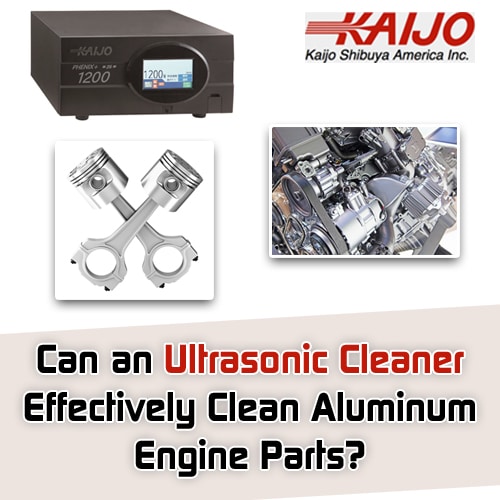Can an Ultrasonic Cleaner Effectively Clean Aluminum Engine Parts?
March 23, 2021
 Because aluminum is a highly reactive metal with comparatively soft surfaces, cleaning with an ultrasonic system has to be carefully adapted to the parts to be cleaned and their contaminants. For automotive parts made from hard metals such as steel or cast iron, low-frequency ultrasonic cleaners operating at 19.5 kHz or 26 kHz can deliver fast and effective cleaning. For aluminum parts, such low frequencies may result in pitting on part surfaces or damage to fragile components. Instead, ultrasonic cleaners that use higher frequencies combined with special cleaning agents can deliver the same excellent cleaning performance for aluminum engine parts as for those made of steel.
Because aluminum is a highly reactive metal with comparatively soft surfaces, cleaning with an ultrasonic system has to be carefully adapted to the parts to be cleaned and their contaminants. For automotive parts made from hard metals such as steel or cast iron, low-frequency ultrasonic cleaners operating at 19.5 kHz or 26 kHz can deliver fast and effective cleaning. For aluminum parts, such low frequencies may result in pitting on part surfaces or damage to fragile components. Instead, ultrasonic cleaners that use higher frequencies combined with special cleaning agents can deliver the same excellent cleaning performance for aluminum engine parts as for those made of steel.
Why Higher Ultrasonic Frequencies Are Needed for Aluminum Engine Parts
Ultrasonic cleaners remove contaminants from the surfaces of the parts to be cleaned by producing microscopic cavitation bubbles in the cleaning solution. The bubbles form and collapse in tune with the ultrasonic frequency. The scrubbing action of the bubbles dislodges dirt and contaminants from part surfaces, allowing them to be rinsed away.
Low frequencies produce comparatively large bubbles while higher frequency bubbles are smaller. When a bubble bursts, it releases a powerful jet that strikes the part surface. The large bubbles from low-frequency ultrasonic cleaners produce jets that are powerful enough to wear tiny holes in soft materials. The smaller bubbles of higher-frequency systems produce less energetic jets that are too weak to affect part surface materials but still powerful enough to remove dirt and contamination.
For aluminum parts used in automobiles or aircraft, frequencies at or above 38 kHz are usually high enough to prevent surface damage. For delicate structures, even higher frequencies may be required to avoid mechanical breakages. A manufacturer of ultrasonic cleaners with experience supplying systems used in automotive and aircraft part cleaning can help customers select the right system for this kind of cleaning application.
Customizing Ultrasonic Cleaners to Clean Aluminum Parts Effectively
Customizing ultrasonic cleaners can help with cleaning aluminum engine parts. For the lower frequencies used for parts with hard surfaces, additional customization is usually not necessary because the cleaning action is already very intense. With higher frequencies, additional measures can help speed up cleaning.
Using solvents in the cleaning solution loosens deposits and dissolves stubborn contamination. Aluminum is highly reactive and will combine with acids and bases to form salts and other chemical derivatives, resulting in corrosion of the aluminum part surfaces. Neutral detergents can be used instead to speed up cleaning and help remove traces and films of contaminants.
For hardened greasy or oily deposits, heat can help soften the contaminants and make them easier to remove. Ultrasonic cleaning tanks can be fitted with heaters to warm the cleaning solution and help clean off oil and grease. The high-frequency ultrasonic bubbles can attack the softened contaminating materials and remove them more quickly than for an unheated process.
Competent ultrasonic equipment manufacturers can help with selection of the neutral detergent or solvent and with the configuration of the heated tanks. Ultrasonic systems customized in this manner can deliver efficient heating despite the lower bubble energies of a higher frequency.
Kaijo Has the Expertise to Deliver the Right Customized Ultrasonic Cleaners
Kaijo’s specialists work closely with customers in the automotive and aerospace industries to ensure they use the right ultrasonic cleaner for their specific application. Choosing the correct frequency, the right neutral solvent and the appropriate heated tank guarantees that customers will receive equipment that cleans as expected.
Kaijo builds all their own equipment and designs the ultrasonic cleaners in house, leaving them ideally situated to customize their equipment. They can analyze customer needs in the automotive and aerospace sectors, to determine which equipment characteristics will deliver the best cleaning performance and choose the corresponding systems from their complete line of ultrasonic cleaners. For special applications such as cleaning aluminum engine parts, Kaijo can reliably deliver the custom ultrasonic cleaners that are required.





